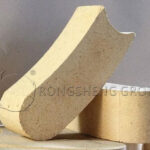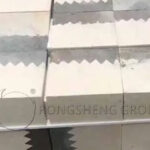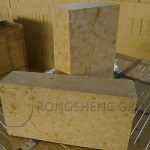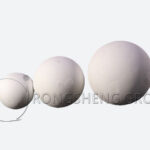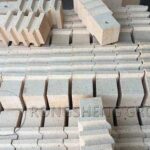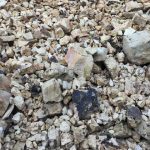As the name implies, anchor bricks are mainly used for anchoring. They are carefully designed and placed in the lining structure of the furnace to firmly fix the refractory materials so that they can withstand extreme conditions such as high temperature, chemical erosion, and mechanical stress. During the operation of the furnace, anchor bricks can effectively prevent the refractory materials from falling off and moving, ensuring the integrity and stability of the furnace lining.
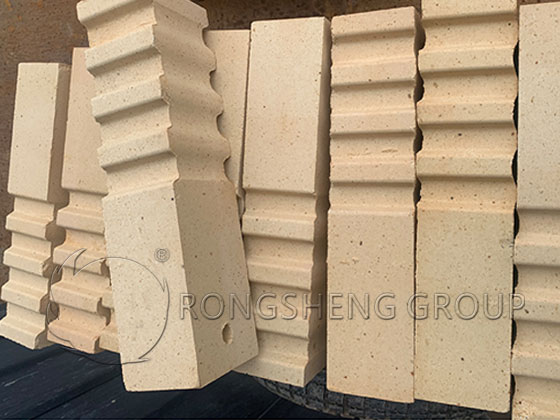
Materials and Classification of Anchor Bricks
In terms of materials, anchor bricks usually need to have good high temperature resistance, chemical corrosion resistance and mechanical strength. Common ones include high alumina, mullite and corundum.
- High alumina anchor bricks have high refractoriness and good thermal shock resistance, and are suitable for industrial furnaces with high temperatures, such as steelmaking furnaces, glass melting furnaces, etc.
- Mullite anchor bricks have excellent high temperature mechanical properties and chemical stability, and are often used in heating furnaces, reforming furnaces, etc. in the petrochemical industry.
- Corundum anchor bricks have extremely high refractoriness and hardness, and are suitable for furnaces with harsh working conditions such as high temperature, high pressure, and strong corrosion, such as gasification furnaces in coal chemical industry.
The shape and structure of anchor bricks are also carefully considered. Various shapes such as L-type, Y-type, T-type, and reasonable size design are all designed to perfectly fit the furnace lining and provide uniform and reliable anchoring force.
The size of the anchor bricks should be reasonably designed according to factors such as the size of the kiln, the thickness of the lining and the operating temperature to ensure that they can withstand sufficient load and remain stable.
Construction Points of Anchor Bricks
- Preparation before installation. Before installing the anchor bricks, the surface of the furnace shell needs to be cleaned and processed to ensure that it is flat, clean, free of oil and rust. At the same time, the anchor bricks need to be quality checked to ensure that they are free of defects and damage.
- Installation position and spacing. The installation position and spacing of the anchor bricks should be arranged strictly in accordance with the design requirements to ensure uniform force and stability of the furnace lining. Generally speaking, the spacing of the anchor bricks should not be too large, otherwise it will affect the anchoring effect.
- Installation method. The installation of anchor bricks is usually carried out by welding or anchor nail fixation. When welding, ensure that the welding quality meets the requirements to avoid false welding, leaking welding, etc. When fixing with anchor nails, the length, diameter and material of the anchor nails should be selected according to the actual situation, and ensure that the anchor nails are firmly fixed to the furnace shell.
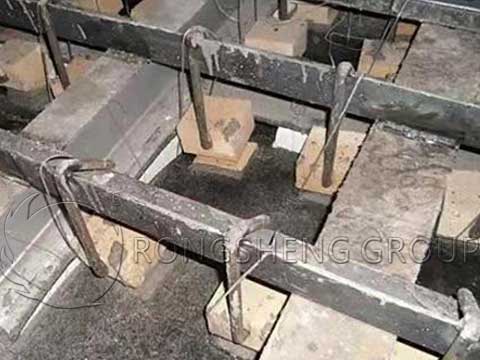
Maintenance and Repair of Anchor Bricks
- Regular inspection. Regularly inspect anchor bricks to see if they are loose, falling off, cracked, etc. Any problems found should be dealt with in a timely manner to avoid further expansion of the problem.
- Replace damaged anchor bricks. When anchor bricks are severely damaged or cannot be used anymore, they should be replaced in a timely manner. During the replacement process, attention should be paid to the quality and installation quality of the new anchor bricks to ensure that they can work properly.
Development Trend of Anchor Bricks
With the continuous advancement of industrial kiln technology and the increasing requirements for energy efficiency and environmental protection, the performance of anchor bricks is also being continuously optimized and improved. In the future, anchor bricks will develop towards higher high temperature resistance, better corrosion resistance and lighter weight to meet the increasingly harsh operating conditions and energy conservation and emission reduction requirements of industrial kilns.
Although anchor bricks are small, they play an important role in industrial furnaces. High-quality anchor bricks, scientific design, fine installation and regular maintenance together constitute a solid guarantee for the stable operation of industrial furnaces.
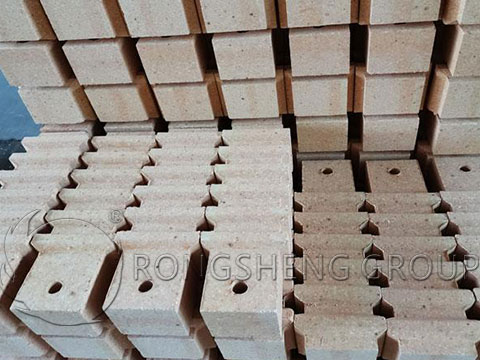
The tensile strength index of anchor bricks is the key to use
In the large-span (greater than 4.5 meters) rolling heating furnaces in the metallurgical industry at home and abroad, the furnace roof often uses a flat hanging roof plate. It is hung on the steel structure of the furnace roof enclosure through hanging parts anchored in refractory castables or refractory plastics. The hanging parts generally use high-aluminum anchor bricks with a length of 180-620mm and an AL2O3 of about 60%.
According to the operating process, use and design conditions, the flat hanging roof plate adopts two methods: integral casting or ramming hanging of the furnace roof and prefabricated block assembly hanging. Prefabricated block assembly hanging has the advantages of convenient installation and construction, rapid maintenance and replacement, but poor overall air tightness.
The furnace roof is integrally cast or rammed hanging, with good air tightness, but it is not suitable for maintenance and replacement. All hanging parts on the furnace roof are required to be in a uniform stress state. Especially when a single hanging anchor brick breaks, it may cause a domino effect on all the hanging anchor bricks on the furnace roof, resulting in the collapse of the entire furnace roof. The reason can be analyzed from the stress state of the hanging anchor bricks: the hanging anchor bricks actually bear static loads (self-weight and part of the weight of the flat hanging top plate), dynamic loads (due to vibration and other reasons) and thermal stress caused by temperature changes.
When the furnace body is working normally, the hot end temperature of the hanging anchor brick in the furnace can reach 1300℃ or even higher, while the cold end temperature exposed to the outside of the flat hanging top plate is between 50℃ and 300℃. From the numerical calculation of finite element thermal stress and the simulation of actual thermal stress test, it can be known that there is a compressive stress field on the high temperature surface of the hanging anchor brick and a tensile stress field on the low temperature surface. The greater the temperature difference, the greater the stress value, which produces a bending effect on the hanging anchor brick. Moreover, the hot end is larger than the cold end, making the hot end easier to damage.
When the furnace body cools down, the temperature of the hot end of the hanging anchor brick in the furnace also drops, and the stress field near it changes from compressive stress to tensile stress. The faster the temperature drops, the faster the stress field changes, forming a tensile stress state at both ends of the hanging brick. When the ultimate tensile strength is exceeded, the hanging anchor brick will crack or even break.
If the hanging brick on the furnace roof breaks, the static load and dynamic load on the bricks adjacent to this hanging anchor brick will increase accordingly. When the comprehensive tensile stress exceeds its tensile strength, it will also break. Correspondingly, the hanging anchor bricks on the entire furnace roof will break one by one according to this effect, and the entire furnace roof will collapse. Therefore, how to accurately measure the tensile strength of hanging anchor bricks has important guiding significance for industrial furnace design, material selection, and furnace body production and operation process.
As a high-temperature material, the damage mechanism of high-aluminum anchor bricks is mainly thermomechanical stress. In practical applications, when the local compressive stress of the material reaches the compressive strength, or the local tensile stress reaches the tensile strength, the cracks are first formed here. Under the combined action of thermal stress and residual stress, the cracks expand, eventually causing the cracking and peeling of high-aluminum anchor bricks. The following is an experimental test of the tensile strength of anchor bricks with different AL2O3 contents.
Some tests were conducted on high-aluminum anchor bricks, and the results showed that the tensile capacity of high-aluminum anchor bricks is lower than the flexural and compressive capacity. The tensile strength is only about 1/13 of the compressive strength and 1/2 to 1/3 of the flexural strength. At the same time, it also verifies the analysis and research that high-aluminum anchor bricks are in an elastic-plastic state when under pressure and in a brittle state when under tension and flexure. The test data also shows that the tensile strength of high-aluminum anchor bricks is lower than the flexural strength and much lower than the compressive strength. When selecting, its stress state should be analyzed and reasonable performance parameters should be selected.

